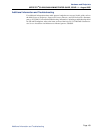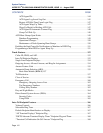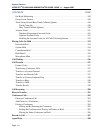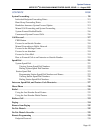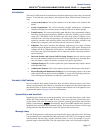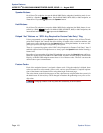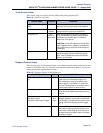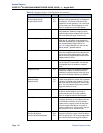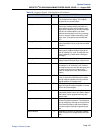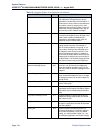
System Features
INTER-TEL
®
CS-5200/5400 ADMINISTRATOR GUIDE, ISSUE 1.1 – August 2005
Introduction
Page 117
Introduction
The Inter-Tel 5000 Network Communications Solutions platform provides many user-friendly
features. To describe the system features, this chapter has been divided into the following sec-
tions:
• Access to the Features: This section contains a list of the feature codes and their defi-
nitions.
• System Organization: This section describes possible administrator assignments,
Attendant arrangements, and hunt groups (including UCD and ACD hunt groups).
• Trunk Features: This section explains the trunk functions and programmable features,
including: dual-tone multi-frequency (DTMF) or dial-pulse signaling; types of trunks
(loop start, T1/E1/PRI); Caller ID, DNIS, and ANI; trunk groups; outgoing access,
allowed-answer, and ring-in assignments; call routing tables; day and night modes of
operation; automatic route selection (ARS); trunk and toll restriction; area/office code
number plans; emergency calls; and direct inward system access (DISA).
• Endpoints: This section describes the endpoints supported by the system. Available
endpoints include IP phones operating in Inter-Tel Protocol (ITP) mode, IP Single-Line
Adapters (IP SLA), SIP phones, digital phones, and Mini-DSS (Direct Station Selec-
tion) Units, and single line endpoints such as single line phones, answering machines,
and fax machines.
• Intercom, Outside, and General Call Processing Features: Several sections explain
the use of the endpoint features that are available to all endpoint users, including inter-
com call features, outside call features, and general call processing features.
• Attendant Features: This section explains the special Attendant-only features and use
of the Mini-DSS Unit.
• Administrator Features: This section explains the special Administrator-only features.
• Record Keeping and Maintenance Features: For record keeping purposes, the system
offers station message detail recording (SMDR). A system error reporting feature pro-
vides self-diagnostic information to make the system easier to service.
Access to the Features
Inter-Tel endpoints have feature buttons that allow one-button dialing of feature codes. Infor-
mation is programmed in the database to determine the arrangement of the feature buttons and
their default values. If desired, some of the endpoint feature buttons can be designated as user-
programmable buttons. See page 168 for more information.
Special Button and Hookflash
Depending on the feature and system programming, users can either enter feature codes imme-
diately after lifting the handset or while on-hook, or they must signal the system before enter-
ing the feature code. Inter-Tel endpoint users signal the system by pressing the Special button
(which is represented by on the endpoint). Single line DTMF endpoint users perform a
hookflash (press and release the hookswitch quickly). If the user does not enter a code or begin
dialing before the Dial Initiation timer expires, the system sends reorder tones.
Message Lamp
Inter-Tel IP endpoints have a Message Lamp located on the upper, right-hand corner. This lamp
is programmable and is defaulted to the Message feature code (365). If you change the feature
code associated with this lamp, it flashes when the feature is active. For example, if you pro-
gram the lamp for Individual Hold (336), the lamp flashes when a call is held at the endpoint.
∞



